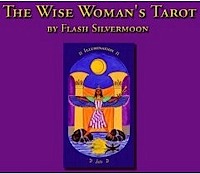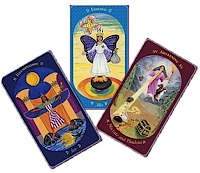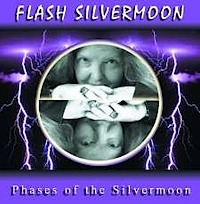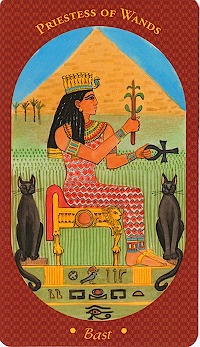By Flash Silvermoon
Excerpt from The Wise Woman's Tarot companion book, copyright 2001-2003
In this volume, I make numerous references to the matriarchal roots of the Tarot. Before I develop this theory further, an explanation of matriarchy is in order. Essentially, matriarchy is a socio-political religious system where woman-rule and/or mother-right predominates. These few words, however, do not adequately express the enormous philosophical chasm that exists between matriarchy and patriarchy. The former shares power, values life and nature, and is communal and cyclical in style, while the latter extols the virtues of power - over materialism, possessions, and private property, and is linear in concept. The first is inclusive, while the second is exclusive, exerting itself particularly forcefully in this present moment in history. I have also made usage of this concept in an archetypal and esoteric sense above.
When one thinks of unconditional love, the first thing that comes to mind is mother-love, the love a mother bestows upon her children. With the (ideal) mother, or Goddess, as the prototype for government and religion, it is easy to see why matriarchal times were gentler times.
Matriarchy, contrary to popular opinion, is not simply patriarchy in reverse. It is this notion of role reversal, and the patriarchy’s fear of reprisal, that sustains the unfair treatment of women and other oppressed groups in patriarchal societies.
During matriarchal times (4,000 to 6,000 years ago), women made laws, governed, were teachers, judges and priestesses as well as mothers and farmers. Marriage as we know it was non-existent and there was matrilineal distribution of property as well as titles (through the maternal side). One of the oldest cities yet excavated is Catal HÃyÃk in Anatolia (now called Turkey). Excavations revealed two secrets:
1. This city showed no evidence of warfare or weaponry in over 200 years.
2. This city was clearly under matriarchal rule.
The concept of an idyllic "land of milk and honey" (milk coming from female animals and women and honey from the matriarchal bee) most certainly refers to a time when matriarchy was in flower. In fact, most findings characterize this period as one of peace and prosperity. According to J.J. Bachofen in his book Myth, Religion, and Mother-Right, matriarchy, like its predecessor, amazonism, and successor, patriarchy, was a world-wide phenomenon, not a mere regional occurrence. There was, however, overlap during transitional periods - when more than one of these systems existed simultaneously. I subscribe to the theory expounded by both Elizabeth Gould Davis and Bachofen, that myth is in fact condensed history. Mythology of the East and West is riddled with tales of male conquerors or gods abducting, raping, and killing Goddesses and female leaders, and usurping their thrones. These myths were attempts of a people (usually male historians) to justify the world-wide spread of patriarchy; in so doing these story-tellers bear involuntary witness to the prior existence of matriarchal systems. The patriarchal revolution didn’t occur overnight and was fraught with terrorism and bloodshed.
Many occult materials are incredibly tainted with this same paradigm of "might makes right." One must choose carefully to gain a good reading background in herstory. Primary sources include Davis’s The First Sex, Merlin Stone’s When God was a Woman and Ancient Mirrors of Womanhood, Anne Kent Rush’s Moon Moon; The Holy Book of Woman’s Mysteries by Zsuzsanna Budapest; Patricia Monaghan’s The Book of Goddesses and Heroines, and this book, as well as others listed in the bibliography. With these one can develop insight into patriarchal distortions of matriarchal beginnings.
In terms of the Tarot, despite patriarchal domination, some vestiges of matriarchal heritage can be un-earthed even in the traditional decks such as the Rider/Waite/Smith. For one thing, though the Emperor bludgeoned his way into a prominent position in the traditional Tarot, he still receives his power only through his "marriage" to the Empress, whom he follows.
In his research for his traditional Tarot deck, the Book of Thoth, misogynistic genius Aleister Crowley refers to three "Great Mother Letters" of the Hebrew alphabet as being Aleph, Mem, and Shin, and a daughter letter, Tau. These letters correspond to Air, Water, Fire, and Earth, respectively; thus, he gives female gender to all the elements. This would lead one to believe that Crowley subscribed to a universe created by, and centered on, the Female Principle. In the next paragraph or so, he allocates the elements of Water and Earth to the Female Principle, and Fire and Air to the Male... bit of a contradiction. Crowley made some innovative steps toward a more accurate understanding of Kabalistic correspondence with the traditional Tarot. He stated that the Star and Emperor had their Hebrew letters reversed. The old translation connects He', a “female” letter, with the Emperor, who is archetypally male, and Tzaddi, a “male” letter, with the Star. He explains that these letters needed to be reversed but he never followed through. This would have involved placing the Star in her rightful place next to the Empress as the third, or Crone, phase of the Lunar Trinity (High Priestess as Maiden, Empress as Mother, and Star as Crone) in the traditional decks. In The Wise Woman’s Tarot Deck, I have made these placement changes that are more in tune with a matriarchal version of the Major Arcana. The Emperor (in my deck, the Amazon), should follow the Mars-ruled Tower (in my deck, Revolution/Revelation). This combination symbolizes the patriarchal revolution, which did in fact take place roughly 4,000 years ago, at the dawn of the Age of Aries.
The Crone is certainly the most potent of the Lunar Trinity, as she controls the province of death and, most importantly, regeneration. During this time that we are inundated by the death-throes of patriarchal rule, the Emperor in traditional decks is where he belongs for the moment, usurping the position of the Crone. How telling that the Emperor, symbol of patriarchal militarism and “law and order,” has taken on the divine power of dealing death – in the most material and cruel sense; yet man, with his total disregard for natural cycles and natural order, has yet to provide any kind of regenerative process to offset his wanton destructiveness.
The Star in traditional decks appears after the Tower, heralding the coming “New Age” of Aquarius, that follows a period of revolution and strife. As the cycle comes round again, the yang imbalance is being countered by the more yin resurgence in women’s spirituality, symbolized by the reordering of the Major Arcana in The Wise Woman’s Tarot. It is my conjecture that the Tarot has always been used in this way – as a kind of time machine/capsule with interlocking symbols that can be positioned by an adept not only to portend, but more proactively to subtly stimulate shifts in consciousness regarding pivotal global/cosmic events.
The dawning Aquarian Age should prove to be a wonderful synthesis of intellectual and emotional, spiritual and material, and even technological and natural energies. Former patriarchal ages saw civilizations using the “either/or” exclusionary system. Hopefully, we will enjoy more of a “both/and,” cyclical, inclusive framework for the coming New Age, so that we can benefit from the gifts and talents of all races, genders, and abilities of human and nonhuman beings alike.
For information about Flash Silvermoon’s The Wise Woman’s Tarot, see her website at http://www.flashsilvermoon.com



